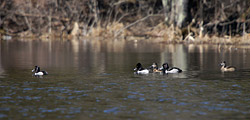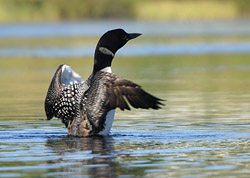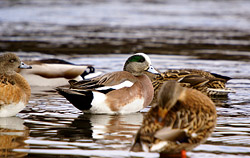Hot Spots
Along the River
LEWISTON WATER TREATMENT PLANT; Lewiston
In winter and early spring this is a good place to look for ducks. The flow of the river in addition to the output from the plant keep a good section of water open here all winter. Look for Bufflehead, Goldeneye, Common and Hooded Mergansers, Mallards and Black Ducks. Scan the trees on the Auburn side of the river for a Bald Eagle. They are seen here often. Check the gulls for unusual species such as Glaucous or Iceland. From Lisbon Street, turn down South Avenue at the Rite Aide store. At the stop sign turn right onto Lincoln Street. You’ll see the Treatment Plant on the left shortly.
SOUTH BRIDGE/CONTINENTAL MILL; Lewiston
Another good vantage point to look for ducks and eagles in winter. Park in the mill parking lot next to the bridge at the end of cedar Street on the Lewiston side on the river. Also, look behind you up to the cross on top of the steeple of the former St. Mary’s Church; A peregrine is know to frequent this high perch for hunting and preening.
ROAK BLOCK; Auburn
This location is best known for the large flock of Mallards that spend the winter, taking hand-outs from well meaning locals. But its worth checking this flock carefully. One Christmas Count turned up a Wood duck; another yielded a Green-winged Teal. Uncommon gulls such as Glaucous and Iceland are sometimes mixed in with the other gulls too. The Eagle is also seen frequently here too. Residents of the Roak Block often see it picking off ducks. On Main Street in auburn, turn into the parking lot of the Roak Block apartments.
GULF ISLAND DAM; Lewiston
A sure place to see Common Mergansers in the winter, along with gulls and crows and an eagle or two. An Osprey nest is visible on a power line pole along this stretch of river, so in the summer keep an eye out for a breeding pair. Heading out outer Main Street, turn left on Switzerland Road. The river is visible and accessible from several points along the road, all worth checking out. In the fall, look for migrating Loons anywhere along here. A Pileated Woodpecker also frequents this area, often seen swooping across the river. Check the trees all along the road for Nuthatches, Brown Creepers, Chickadees and Titmice at any time of year, and in the spring, look for warblers. In the winter, you’re almost sure to see a Bald Eagle or two along this stretch of river. Check the large pines across the river, and keep an eye out overhead. If the gate to the dam area is closed, park on the side of the road and walk in. Again in the winter, look around the dam for Iceland and Glaucous Gulls.
NORTH RIVER ROAD; Auburn
North River Road is a wonderful birding site. It parallels the Androscoggin River, but most of the birding is not on the water. It offers a great diversity of habitat from beginning to end. Spring and early summer offer the best birding.
North River Road starts at Center Street directly across from the Center Street Shopping Plaza, heading off behind Wendy’s. Your first stop should be right after Higgins Sports where the river backs up into a little cove. Great Blue Herons are often seen here, and occasionally other herons and egrets stop by. The bushes on the other side of the road are sure to harbor a Yellow Warbler or two, and most likely a Common Yellowthroat. The Yellowthroats can easily be “pished” out. Scan the trees on the hill for cardinals and orioles.
A little further up the road there is a dirt path on the right blocked off by stones. Park here and follow the path down to the river. Listen for vireos and flycatchers here, particularly the Great Crested Flycatcher. Rose-breasted Grosbeaks are also seen here frequently. Along the river, watch and listen for the Belted Kingfisher. The path comes back out on the road a short distance from your car. As you head back, keep an eye and ear on the tall pines for orioles, woodpeckers, cardinals and warblers; especially the Pine Warbler.
Your next stop is just up the road at the small bridge. This is where Bobbin Mill Brook flows into the Androscoggin. When you get out of your car, close the door quietly, and walk carefully to the bridge. Often there will be a Great Blue Heron feeding in the brook on the up-stream side of the bridge. In the summer when the water is low, Green Herons sometime feed on the sand bar on the opposite side of the bridge. A White-crowned Nightheron has sometimes been seen roosting in the trees over the brook.
During spring migration this spot is a flurry of activity. Redstarts, Chestnut-sided and Yellow Warblers, and Yellowthroats are just some of the warblers you’re likely to see. Orioles tend to congregate here too. As many as five males have been seen here at one time. Also listen for a House Wren in the bushes on the other side of the bridge.
A little further up the road you’ll come to some corn fields on the right. Geese frequent these fields in spring. Check for Canada and Snow Geese, and possibly others. You will also likely see Tree, Barn and Rough-winged Swallows. Watch the hedgerow on the other side of the road for orioles, especially when the fruit trees are in blossom.
From here there are many farms and farm fields. Search them for Bluebirds, Meadowlarks and Bobolinks. Check any small ponds for Solitary Sandpipers.
Further on the fields turn to woods. There are some logging roads worth walking, especially in May. Besides a wealth of warblers, you’ll definitely hear Ovenbirds and White-throated Sparrows. Listen for vireos, flycatchers, nuthatches and woodpeckers.
When the road takes a sharp bend to the left, you’re almost at the end. Keep an eye open for a Scarlet Tanager in the woods, and listen for Black-throated Green Warblers. At the stop sign, take a left and you’ll be headed toward Center Street and Lake Auburn, and your next hot spot.
Lake Auburn & Vicinity
BOAT LAUNCH/OUTLET BEACH AREA; Route 4
Where Center Street cuts between Lake Auburn and the Outlet Beach area, pull off the road and check both sides for waterfowl. Spring and fall are best here. Look for Hooded Mergansers, Bufflehead, Ring-necks, Mallards, cormorants and more. In the fall you might find Ruddy Ducks and Coots. Check the lake side for loons in spring and fall.
MARSHY AREA; Lake Shore Drive (We need a name for this place)
Further up Route 4, take a left onto Lake Shore Drive directly across from St. Phillip’s Church. A little way up this road you’ll see an area to pull off on the left. Park here. Check the lake for loons, ducks and gulls. In the late fall you might even see an eagle or two soaring overhead.
Most of the action is on the other side of the road in the marshy backwater. Look carefully among the cattails for ducks of all kinds, especially Wood Ducks. Mallards and Black Ducks are a given here. In the fall you may see coots.
Swallows and Red-wing Blackbirds are also a sure thing. Great Blue Herons are commonly seen feeding among the reeds, and an occasional American Bittern, but you might have to look carefully to find them. More conspicuous are the Belted Kingfishers, sometimes seen chasing each other over the water.
Spring brings a wave of warblers. This is perfect habitat for the Wilson’s Warbler and Northern Waterthrush, birds you don’t see just anywhere.
LAKE AUBURN INLET;
Continue out Lake Shore Drive all the way to the end (Lake Auburn will be on your left the whole way). At the stop sign is the inlet to Lake Auburn. In the fall, this is a pretty sure place to find Hooded Mergansers. You are also likely to see a Belted Kingfisher, and check the lake itself for other ducks and Loons. Follow the stream across the road, upstream, and look for warblers and sparrows.
THE BASIN; Holbrook Road
From the stop sign at the inlet, turn left onto North Auburn Road, which immediately starts going up a hill. Take the first right onto Holbrook Road (at the Auburn Land Lab, the old C.P. Wight School); in less than a mile you’ll see a dirt road on your right that leads a very short distance to an undeveloped boat landing. “The Basin” is a narrow pond formed by a dam that regulates the flow of water into Lake Auburn. You can do some birding from the shore (the boat landing provides a good view), but canoeing up into the winding northern reaches of the Basin in summer can reveal Double-crested Cormorant, Great Blue Heron, several duck species, Osprey, flycatchers (sometimes including nesting Eastern Kingbird), Yellow Warbler, Northern Waterthrush, American Redstart, and other warblers, Redwing Blackbird, Song and Swamp Sparrows, and American Goldfinch. In the spring and fall the Basin often hosts Ring-necked Duck, Hooded Merganser, Common Goldeneye, and other interesting duck species.
A Bit Farther Afield
NEW GLOUCESTER MARSH
The extensive marshes bordering the upper reaches of the Royal River are quite reliable in spring for Virginia Rail (and, to a lesser extent, Sora), Marsh Wren, Swamp Sparrow, Yellow Warbler, Common Yellowthroat, and several other warbler species, Redwings, several different swallows and flycatchers, and Gray Catbird. American Bitterns are often seen as well. The great advantage of this particular spot is that a train track traverses the middle of the marsh, so the walk is both dry underfoot and offers the relative height of the railroad bed as an observation platform.
Directions: From Auburn, go south on Routes 4/100/202 through “Upper Gloucester” to Route 231 (a left-hand turn at the blinking yellow light). It goes past the New Gloucester elementary school, through the “center” of New Gloucester, and down a hill. Just past the railroad crossing at the bottom, pull off the road to park and walk north along the tracks until the marsh opens out, especially to the left.
GRAY MEADOW
The abandoned track bed of the old Interurban Electric Trolley cuts through woods and across a large wet meadow (marsh?) south of Gray. The woods have many possible warbler species in the spring, as well as an occasional Black-billed Cuckoo, Rose-breasted Grosbeak, or vireos. Out on the marsh, swallows, ducks, sparrows, flycatchers, and blackbirds are all to be expected.
Directions: From Auburn, go south on Routes 4/100/202; in Gray, go south on Routes 26/100 about 2 miles; look for Long Hill Road, a sharp left. Turn left onto Long Hill Road, go a few hundred yards until a snowmobile trail crosses it (it’s more visible on the left); this is the old trolley railbed. Park along the road, take the trail to the left (north), through some wet woods (good warbler territory), which turns into the abandoned railbed crossing the marsh. Go as far along the trail as time permits.



